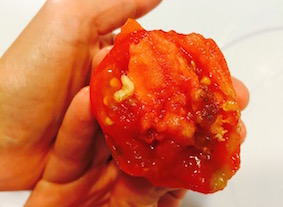+86- 111****
Boluo county dragon Lotus Lake Village Town Industrial Park, China

Just when you think everything is going great in the garden, pests rear their ugly little heads.
And do I mean ugly. Take a look at that whitish larval critter in the photo above. I’m not exactly sure what it is. If I were to see it all by itself, I would identify this as a pepper maggot. I’ve become way too familiar with pepper maggots over the years, and this looks just like one.
However, this little guy—and several others I have found—popped up in my tomatoes. Yes, my tomatoes. And I’m not too happy about it either.
First, how did I discover it? A freshly harvested tomato appeared to have a small rotten spot developing along the side. The tomato also happened to have some black spots that I believe to be bacterial spots. Concerned that the bacterial spot was causing some sort of rot, I cut into the tomato to find this white larva.
I have since found these white larvae in about three or four other tomatoes. In all instances these tomatoes appeared to have small wet-looking brown spots. In one cherry-sized tomato I could clearly see an entry hole. In another I spotted the entry hole after cutting into the tomato. That hole appeared to be under where the stem attaches to the fruit.
Well, pepper maggot flies have been known to lay their eggs on the “shoulders” of the fruit, and that is where I found the entry holes in the tomatoes. Tomatoes and peppers are in the same plant family, so pepper maggot flies may be attracted to another plant that is closely related. And by golly, this sure does look like a pepper maggot.
However, it also looks very much like a fruit fly maggot. And that little item is the one thing that stops me from claiming with 100 percent certainty that it is indeed a pepper maggot.
The question is, what to do? I won’t be popping cherry tomatoes into my mouth without a careful examination of fruit, that’s for sure. I’ll inspect all my tomatoes for wettish-looking brown spots and entry holes, too. Preventatively I will direct my nozzle with a gentle force when watering, in hopes of dislodging any eggs that may have been laid. As far as insect controls go, I’ll have to look into that and report back.